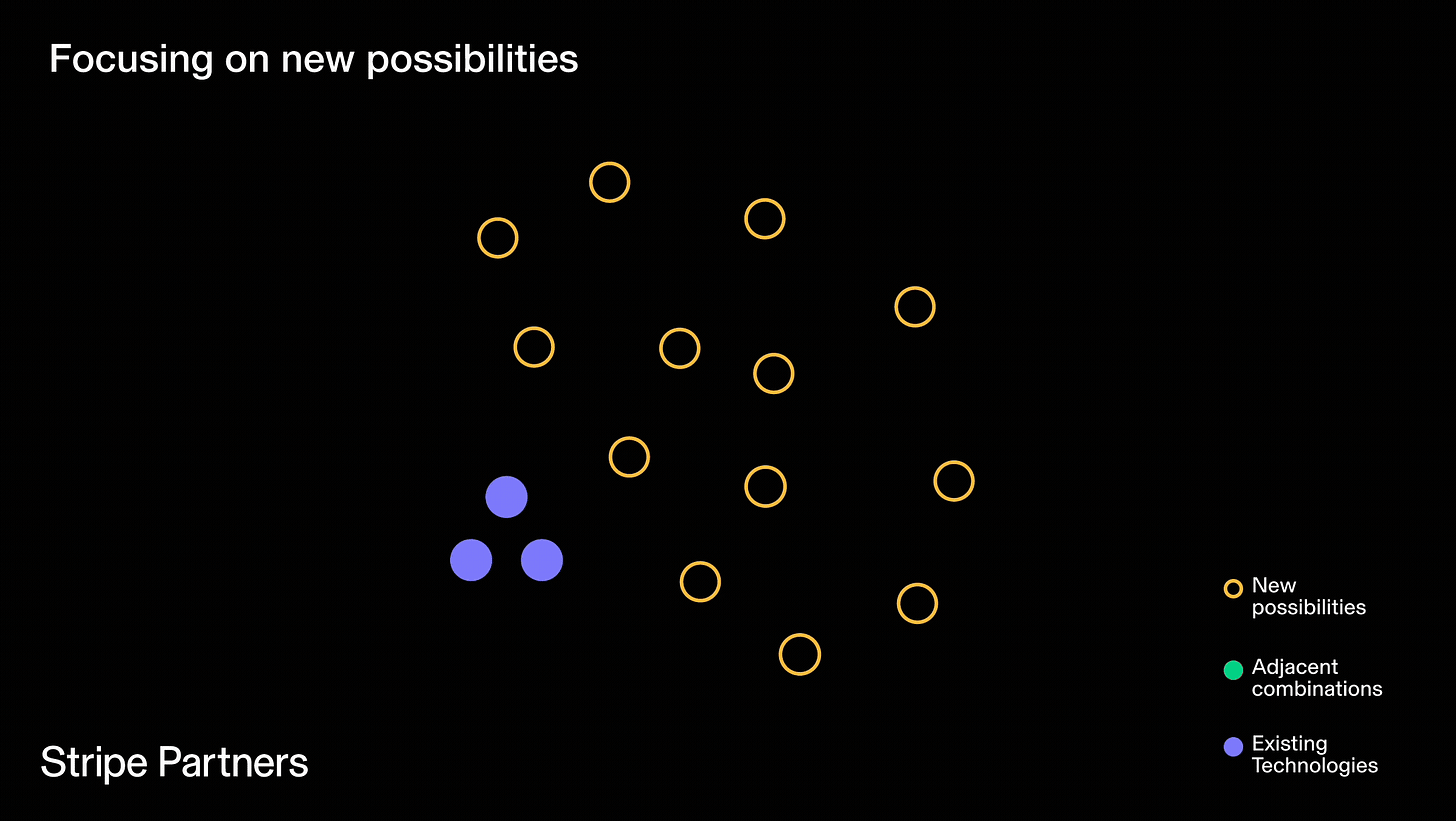This month’s Frame: using W. Brian Arthur’s “adjacent possibility principle” to perfect products
A framework to encourage product teams to focus on the established not just the novel.
The ritual calendar of the technology year is punctuated by the developer conferences held by many large technology companies: Google I/O, Microsoft’s Build, Apple’s WWDC and Meta’s Connect. They are gatherings not just of developers but devotees. Whoop, gasps and applause accompany the unveiling of new products and features by a cast of casually-clothed executives. There’s always “one more (new) thing”.
Meanwhile on Main street, online forums, and at the coal face of knowledge work, exasperated users express their frustration that the innovations launched in earlier years continue to underwhelm or frustrate. With every announcement of a new AI tool that solves a latent need or offers new possibilities further down the technology stack there are many users who ask themselves why a much older, familiar technology continues to thwart their attempts to complete apparently simple tasks. Dropping and positioning an image in a word document often leads to audible groans of frustration. Synchronous document collaboration—a mainstay of modern knowledge work—can still be a laggy and exasperating experience.
A straightforward, if cynical, explanation for this is the observation that in a financialised world the primary product of listed companies is their stock. The real customer base for most listed companies is investors and analysts. They need the reassurance of a flow of shiny new things to support future earnings growth. New features signal innovation and progress to investors.
A more charitable explanation is the engineering sophistication of these companies: skilled engineers enjoy focusing on new creations more than making marginal improvements to older products.
But the work of economist W. Brian Arthur, articulated in his short but influential book “The Nature of Technology: What It Is and How It Evolves”, offers a more sophisticated explanation of why the novel too often casts a long shadow over the technology produced in prior innovation cycles.
Grappling with the underlying dynamic which leads technology innovation to focus on “one more thing” can help focus product owners’ attention away from the new towards their older creations. This redirection could ensure that past innovations are not left to wither on the vine and instead perform better for their everyday users.
The framework
The core idea of Arthur's theory is that technology evolves by combining existing technologies to create new ones. His fundamental insight is deceptively simple: all technologies are built from other technologies. Uber merged GPS technology, mobile apps, payment processing systems, mapping software, microservices architecture and telecommunications into a transportation service. Uber’s breakthrough wasn't inventing any of these components but recognising their potential when joined together.
This is what Arthur calls "combinatorial evolution"—as the stock of available technologies grows, the number of possible combinations grows exponentially. Technology doesn't advance through isolated breakthroughs but through an endless process of mixing, matching, and recombining existing elements in novel ways.
Each new technology opens up new spaces of possibility. Arthur calls this the “adjacent possibility principle”. The implication is that technological progress is self-accelerating as each new technology becomes a potential component for future technological bricolages, expanding the combinatorial space. The more technologies we have, the more new technologies become possible to create. This creates a powerful psychological and strategic pull toward novelty that often overwhelms the impulse to perfect existing solutions.
The result: when companies create new features, they're exploring newly accessible technological possibilities rather than optimising within established spaces. The adjacent possibility principle explains why companies perpetually build new features or products rather than refining existing ones.
Consider a company that develops basic GPS navigation for cars. Once they have working turn-by-turn directions, the adjacent possibility space suddenly expands dramatically. They can now see opportunities for real-time traffic integration, voice commands, point-of-interest recommendations, route optimisation for fuel efficiency, fleet management systems, and location-based advertising. The original GPS system might have poor user interface design, slow route calculation, or inaccurate maps. But instead of fixing these fundamental issues, the company finds itself drawn to exploring these newly visible possibilities. Traffic integration feels like a strategic breakthrough opportunity. Voice commands promise to differentiate from competitors. Location-based services open up new revenue streams.
Using the framework
The quest to consistently build the novel is unlikely to be halted. In fact, if Arthur’s theory is accepted it should be seen as an inalienable feature of the way the technology industry operates. Yet it’s possible to flip the adjacent possibility principle to make the case for focusing on existing technologies by reframing what constitutes the "adjacent possible."
Zoom's focus on perfecting video call quality during the pandemic revealed adjacent possibilities that competitors missed. Ultra-low latency enabled real-time collaboration, or a level of audio clarity that made large group calls viable. These weren't new features but emergent capabilities that arose from deep technical excellence. The adjacent possible here wasn't adding diary integration, an AI Companion or “Revenue Accelerator”—it was unlocking entirely new use cases through technical depth.
Zoom’s strategic moat arose from technical depth that was initially harder for competitors to replicate than surface-level feature combinations. “It just works” is preferable to calendar integration, the addition of “workspaces” and sophisticated backgrounds. Indeed one might argue that Zoom’s subsequent decline neatly tracks its insistence on adding endless new features and overburdening the UX/UI of the product.
This suggests that focusing on deep technical mastery at the core of the product typically reveals more valuable adjacent possibilities than chasing surface-level feature proliferation to “wow” customers (and investors). From its early years, Amazon focused on logistics and warehouse automation. This focus revealed massive adjacent possibilities: cloud computing (which turned into the lucrative AWS business), and a prominence in logistics that provided a strategic moat and led, in time, to Prime and logistics as a service for other companies.
Arthur’s adjacent possibility principle explains the ineluctable pull in the technology industry to create a stream of new things. Resisting this urge is not easy. It’s hard wired into the nature of technology itself and amplified by the market dynamics of the industry. Yet the prize for defying the new, and focusing on improving the existing, is an improved core user experience that builds a more effective moat than an endless parade of shiny new things.
Interested in exploring similar topics further? Explore our archive of past Frames for fresh perspectives:
In last month’s Frame, we explored how learned behaviors including the swipe gesture, popularised by Tinder, become embedded into design systems, and repeated across products and contexts. Richard Schechner’s “restored behaviours” can help us understand how these behaviors circulate.
Another important lens is the temporal dimension in how we conceive of platforms and communities. In “building for successors and predecessors,” we consider how Alfred Shutz’s “lifeworlds” can help us design for those we don’t know and will never know.
Many users feel they are losing control of technology. Using the theories of Langdon Winner, we propose that moving from a “blackboxed” technology-first state to a “human-first” approach can help us regain a sense of control.
Frames is a monthly newsletter that sheds light on the most important issues concerning business and technology.
Stripe Partners helps technology-led businesses invent better futures. To discuss how we can help you, get in touch.





I have deep respect for W. Brian Arthur. But credit to where credit is due: the term "adjacent possible" originates from theoretical biologist Stuart Kauffman. It is not W. Brian Arthur's theory.